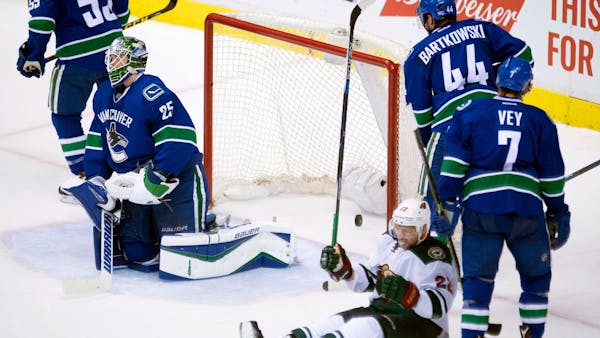There is a school of thought that suggests a team that fires a head coach in the middle of a season gets at least a temporary boost when a new coach takes over.
Jon Bois at SB Nation was curious about this conventional wisdom a few years ago and compiled data from 12 seasons of midyear firings. He found that there isn't typically much of a bump, though across the board in the NFL, NBA, MLB and NHL the new coach does have more success than the previous coach.
What's particularly interesting is that he finds the NHL had the most "successful" firings of the leagues, with 15 of the 52 teams who fired coaches going on to make the postseason that year. The NHL teams had a winning percentage of .462 before the firings and .507 after.
What does that mean for the Wild and new coach John Torchetti? Well, it's too soon to tell for sure — though a 5-2 victory Monday in his debut at Vancouver was encouraging.
The Wild still has a better than 40 percent chance of making the playoffs, per Hockey Reference. That's up from just below 30 percent a couple days ago. So it happens a lot in the NHL and the Wild is still very much in the mix. Maybe it can happen here?
We can also look for evidence of a firing "bump" by looking at other local coaches who have been fired mid-year and how their successors fared. While "Torch" is the first mid-year Wild replacement, it's happened plenty with other teams. Here are some notable examples:
VIKINGS
Mike Tice: Replaced Dennis Green in 2001 with just one game left in the regular season and lost 19-3 at Baltimore with Spergon Wynn as his starting quarterback. Verdict: Green was fired too late in a lost season for Tice to have an impact that year.
Leslie Frazier: Replaced Brad Childress in 2010 after a 3-7 start. The Vikings Won 17-13 at Washington in Frazier's debut and went 3-3 under the new coach to finish the season. Verdict: The season couldn't be saved, but Frazier turned a disastrous year into a more respectable finish.
TIMBERWOLVES
Sidney Lowe: Replaced Jimmy Rodgers during the 1992-93 season. Verdict: Lowe went 13-40 after Rodgers went 6-23 — a modest improvement but pretty much a wash.
Flip Saunders: Replaced Bill Blair during the 1995-96 season. Verdict: Blair was 6-14; Saunders was 20-42. So Flip didn't save the season, but he had the Wolves in the playoffs the next eight years after that.
Kevin McHale (the first time): Replaced Flip Saunders in the 2004-05 season after a 25-26 start. The Wolves lost 87-83 at home to the Bulls but went 19-12 overall under McHale. Verdict: There was surely a bump, though the Wolves didn't rebound to make the playoffs.
Randy Wittman: Replaced Dwane Casey almost exactly halfway through the 2006-07 season. Casey went 20-20. Wittman went 12-30. Verdict: This firing did the opposite of helping. It hurt.
McHale (second time, 2008-09): Replaced Wittman. Verdict: The Wolves lost their first eight games under McHale. But they were 20-43 overall under McHale after going 4-15 under Wittman, so it was an improvement.
TWINS
Tom Kelly: Replaced Ray Miller late in the 1986 season and won won his debut, 4-2 over Texas. Verdict: Kelly went 12-11 after the Twins went 59-80 under Miller. Again, the season couldn't be saved but the Twins did get a late bump. And they did, you know, win the World Series the next year under Kelly.
GOPHERS MEN'S BASKETBALL
Jim Molinari: Replaced Dan Monson in the 2006-07 season. Verdict: Monson was fired after a 2-5 start. Molinari went 7-17 the rest of the way, including 3-13 in the Big Ten. Neither guy did well.
GOPHERS FOOTBALL
Jeff Horton: Replaced Tim Brewster in the 2010 season. Verdict: Brewster started 1-6 before he was fired. Horton lost his first three games but won his final two, including an upset of Iowa in the finale, so there was certainly a bump in this case.
In heated western Minn. GOP congressional primary, outsiders challenging incumbent

Minnesota Sports Hall of Fame: A class-by-class list of all members

This retired journalist changed professional wrestling from Mankato

